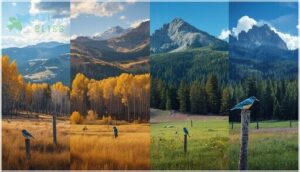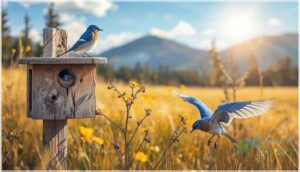This site is supported by our readers. We may earn a commission, at no cost to you, if you purchase through links.

A flash of cerulean blue against a ponderosa pine catches your eye, and suddenly you’re hooked—Colorado’s blue birds turn everyday mountain trails into treasure hunts. The state hosts six distinctive blue species, from the sky-colored Mountain Bluebird hovering over high-altitude meadows to the bold Blue Jay expanding its territory along suburban neighborhoods.
Each species claims different elevations and ecosystems, creating a vertical mosaic of blue from the grasslands to the alpine zones. Whether you’re scanning open fields at 10,000 feet or watching your backyard feeder, knowing which blue bird you’ve spotted transforms a pleasant sighting into a deeper connection with Colorado’s avian geography.
Table Of Contents
- Key Takeaways
- Types of Blue Birds in Colorado
- Physical Characteristics and Identification
- Habitats and Distribution Across Colorado
- Behavior, Diet, and Nesting Habits
- Conservation and Attracting Blue Birds
- Frequently Asked Questions (FAQs)
- What birds in Colorado are blue?
- What does a Colorado blue bird look like?
- How to attract bluebirds in Colorado?
- Are there blue jays in Colorado?
- What predators commonly threaten bluebirds in Colorado?
- How long do bluebirds typically live in the wild?
- Can bluebirds recognize individual human faces?
- Do bluebirds have any unique vocalizations or calls?
- How do Colorados bluebirds cope with extreme weather events?
- What predators threaten blue birds in Colorado?
- Conclusion
Key Takeaways
- Colorado hosts six distinctive blue bird species that occupy different elevations and ecosystems, creating a vertical mosaic from grasslands to alpine zones up to 14,000 feet, with Mountain Bluebirds favoring high-altitude meadows while Western Bluebirds thrive in ponderosa pine forests between 5,000 and 8,000 feet.
- Male blue birds display vibrant plumage to attract mates while females wear muted gray-blue tones for nest camouflage, and each species has distinctive vocalizations that serve as acoustic adaptations to their specific habitats, making both sight and sound essential for accurate identification.
- Conservation efforts combining volunteer programs like the Colorado Bluebird Project with nest box installations have proven effective despite Mountain Bluebird populations declining nearly 5.5% annually since 1980, showing that citizen science and backyard habitat creation directly impact species survival.
- Blue birds shift their diets dramatically between seasons, consuming insects like grasshoppers and beetles during breeding months through specialized foraging techniques like hovering or ground-gleaning, then switching to berries from elderberry, sumac, and dogwood to sustain them through Colorado winters.
Types of Blue Birds in Colorado
Colorado’s skies host an impressive variety of blue birds, each with its own unique charm and characteristics.
You’ll find everything from the sky-blue Mountain Bluebird to the bold Blue Jay, along with several species that might surprise you.
Let’s look at the blue birds you’re most likely to encounter across the state.
Mountain Bluebird
The Mountain Bluebird stands out as Colorado’s most vibrant blue bird species. Males display vivid turquoise-blue plumage across their upper parts, while females show duller grayish-brown tones with subtle blue accents on wings and tail.
You’ll spot these bluebirds performing distinctive hovering flight while hunting insects across open mountain meadows and grasslands, from 5,000 feet elevation up to alpine zones reaching 14,000 feet. The male is known for its dark-blue head and wings, a key identifier.
Western Bluebird
While Mountain Bluebirds favor higher elevations, Western Bluebirds thrive in Colorado’s ponderosa pine forests between 5,000 and 8,000 feet. You’ll identify males by their distinctive features:
- Dark purplish-blue throat and head
- Rust-colored chest and shoulders
- Gray-blue belly
- Characteristic hunched perch posture
- Wingspan of 11.4 to 13.4 inches
Breeding success in Colorado depends heavily on nest box design and forest management practices that maintain open woodland structure. They often nest in old woodpecker holes for shelter.
Eastern Bluebird
You’ll find Eastern Bluebirds primarily in Colorado’s northeastern corner, where they favor lowland riparian deciduous woodlands. Males display bright blue backs with rusty red throats, while females show more subdued colors. Population recovery efforts have helped these birds bounce back from nesting competition with European Starlings and House Sparrows, though breeding rates remain challenged by harsh winters.
| Feature | Male | Female |
|---|---|---|
| Back Color | Bright Blue | Grayish-Blue |
| Throat/Chest | Rusty Red | Pale Orange |
| Diet (Breeding) | 68% Insects | 68% Insects |
| Migration Distance | Up to 1,400 miles | Up to 1,400 miles |
| Clutch Size | 4-7 Eggs | 4-7 Eggs |
Their insect diet during breeding season aids rapid chick growth, with butterfly larvae, beetles, and grasshoppers comprising most prey items.
Blue Jay Species
Blue Jays (Cyanocitta cristata) have expanded their range along Colorado’s Front Range, appearing most frequently in the eastern third. You’ll recognize them by their crested heads, bright blue plumage with black barring, and bold social behavior in small bands.
Their omnivorous diet includes acorns they cache for later, inadvertently aiding forest propagation. Hybridization with Steller’s Jays occurs in eastern foothill zones, while their conservation status remains stable.
Indigo Bunting and Blue Grosbeak
During breeding season, you’ll encounter two migratory bird species in Colorado’s brushy woodland edges: the Indigo Bunting (Passerina cyanea) and Blue Grosbeak (Passerellina caerulea). Range expansion has brought Indigo Buntings to southwestern Colorado, where habitat overlap creates nesting competition.
Males display vibrant blue plumage, though Blue Grosbeaks are larger with distinctive brown wing bars. Their foraging behavior differs—Indigo Buntings prefer elevated perches while Blue Grosbeaks forage ground-level, catching grasshoppers and beetles.
Other Notable Blue Birds
Beyond the bluebirds, you’ll spot several species with blue plumage across Colorado habitats. Belted Kingfishers display distinctive rattling calls near water, while Tree Swallows and Violet-green Swallows perform aerial insect-catching during migration periods.
Mountain Chickadees inhabit coniferous forests, their diet shifting seasonally between insects and seeds. Cavity nesting attracts these species to appropriate sites.
Steller’s Jays and Blue Jays frequent woodlands, alongside Lazuli Buntings in shrubby areas.
Physical Characteristics and Identification
When you’re out in the field, knowing what to look for makes all the difference between a quick glance and a confident ID.
Blue birds in Colorado show some fascinating variations in color, pattern, and sound that can help you tell one species from another. Let’s break down the key features you’ll want to watch for.
Male Vs. Female Plumage
You’ll spot striking differences when comparing male and female bluebirds in Colorado. Male species display vibrant structural color—cerulean blues in Mountain Bluebirds, bright blue with rusty-orange chests in Western Bluebirds—while female species show muted gray-blue tones.
This sexual dimorphism has dual purposes: males signal fitness for mate selection, and females use camouflage strategies to protect nests from predators, demonstrating evolutionary adaptation in plumage variations.
Male bluebirds wear bright colors to attract mates, while females stay camouflaged to protect their nests from predators
Juvenile Identification
Young bluebirds wear plumage that can challenge your identification skills, but you’ll master recognition with these key features:
- Spotting Patterns: Mountain Bluebird juveniles show sparse back and belly spots, while Eastern Bluebirds display heavy breast spotting characteristic of thrush family birds.
- Bill Morphology: All juvenile bluebirds possess small, entirely black bills aiding species-level identification.
- Molting Process: Immature males develop patchy blue-brown plumage during gradual feather replacement.
Distinctive Vocalizations
You can identify Colorado blue birds by their distinctive vocalizations, which serve as acoustic adaptations to varied habitats. Mountain Bluebirds produce emphatic chirruping songs at dawn, while Western Bluebirds emit short “pew” calls and chattered “chuck” sounds. Eastern Bluebirds deliver rising “chur-LEE” calls, and Blue Jays use complex “whisper songs” during breeding.
Indigo Buntings repeat sharp, clear notes in pairs, demonstrating vocal learning and regional dialects that aid bird identification throughout the state.
Seasonal Plumage Variations
You’ll notice blue bird plumage shifts dramatically through the year due to molting and brightness changes. During July and August, bluebirds replace worn feathers, revealing vibrant breeding plumage as buffy tips wear away.
Male and female bird differences become more pronounced by spring, while juveniles develop from gray to adult coloration.
Geographic variation and light conditions further affect how you perceive their striking blue coloration throughout Colorado’s seasons.
Habitats and Distribution Across Colorado
Colorado’s diverse landscapes create distinct habitats where you’ll find different blue bird species throughout the year. From wide-open prairies to dense forest edges, each environment attracts specific birds adapted to those conditions.
Understanding where these birds live helps you know exactly where to look during your next birdwatching adventure.
Grasslands and Open Fields
Across Colorado’s open grasslands and meadows, you’ll find bluebirds thriving where insect abundance peaks during spring and summer. Mountain and Western Bluebirds depend on this habitat for nesting success, though habitat loss threatens their populations.
Conservation programs address these challenges by installing nest boxes in open fields, and these efforts have proven particularly effective in maintaining populations even in wintering grounds at lower elevations.
Woodlands and Forest Edges
Where open grasslands meet forest edges, you’ll discover ideal bluebird territory. Mountain, Western, and Eastern Bluebirds use these edge habitat zones for nesting and foraging, with conservation efforts targeting woodland corridors near Littleton and state parks.
Population trends show nesting success increases when nest boxes appear on forest edges, where Colorado’s open woodland habitats support cavity-nesting bird species year-round through their ecological role as insect controllers.
Wetlands and Riparian Zones
You’ll find remarkable riparian bird diversity along Colorado’s rivers and wetlands, where cottonwoods, willows, and blue spruce create critical habitat supporting over 40% of the region’s bird species. These riparian areas attract Mountain Bluebirds, Tree Swallows, and Belted Kingfishers to water sources despite covering just 2% of Colorado’s landscape.
- Artificially created wetlands from flood irrigation provide important breeding grounds
- Water management impact directly affects avian species dependence on these ecosystems
- Conservation program success relies on maintaining healthy riparian corridors
Suburban and Urban Areas
Beyond natural spaces, bluebirds have mastered habitat adaptation in suburban parks and urban green areas across Colorado. Eastern Bluebirds frequently appear in backyards, while Western and Mountain Bluebirds rely on nest boxes to offset lost cavity sites. Their foraging strategies adjust to lawns and gardens, where they can be spotted hunting insects. Urban migration patterns now include cities, thanks to citizen involvement in installing nest boxes and bird feeders—attracting birds to backyards benefits conservation efforts statewide.
| Species | Suburban Behavior | Food Sources |
|---|---|---|
| Eastern Bluebird | Nests in man-made cavities on lawns | Caterpillars, grasshoppers, ants |
| Western Bluebird | Uses nest boxes in residential zones | Insects, mistletoe, juniper berries |
| Mountain Bluebird | Forages in open grassy suburban areas | Ground insects, flies |
Regional Hotspots for Sightings
You’ll want to hit Colorado’s standout birdwatching locations for your best bluebird sightings. The Front Range and Foothill Regions deliver Western Bluebirds around Garden of the Gods, while Pawnee Grassland showcases Mountain Bluebirds across open country.
On the Western Slope, Colorado National Monument consistently reveals Western Bluebirds.
Down south, the San Luis Valley and surrounding wildlife refuges attract diverse Colorado bird species year-round.
Behavior, Diet, and Nesting Habits
Understanding how blue birds live their daily lives helps you appreciate what you see in the field. Their feeding habits, nesting choices, and seasonal movements reveal why certain species thrive in Colorado’s diverse landscapes.
Let’s explore the key behaviors that define these stunning birds throughout the year.
Feeding Preferences
Colorado’s blue birds shift their seasonal diets dramatically. During breeding, you’ll observe insectivores like Mountain Bluebirds consuming grasshoppers, beetles, and spiders using hovering foraging techniques. Western Bluebirds glean insects from the ground, while Eastern Bluebirds capture prey mid-flight.
Come winter, fruit preferences emerge—elderberries, sumac, and dogwood sustain them. Blue Jays prefer feeder choices like peanuts and sunflower seeds year-round.
Migration Patterns and Timing
Tracking migration patterns reveals fascinating seasonal bird migration across Colorado. Mountain Bluebirds arrive in early spring, sometimes by February, while Eastern and Western Bluebirds migrate in late summer through fall.
Migration triggers include temperature shifts and food availability, with climate influence determining stopover locations along the Front Range corridor.
You’ll notice flock behavior during peak migration, as population shifts create striking viewing opportunities mid-September through early October.
Nesting Sites and Cavity Use
Cavity nesting birds like Mountain and Western Bluebirds rely on natural tree hollows and nest boxes for breeding and nesting. Mountain Bluebirds prefer larger cavity size preferences (1 9/16 inches), while Western Bluebirds use slightly smaller entrances.
Habitat suitability matters more than nest box placement alone—open meadows attract Mountain Bluebirds, though nesting competition from Tree Swallows and House Wrens challenges bluebird nesting habits throughout Colorado’s varied landscapes.
Interaction With Other Bird Species
Territorial dominance shapes how blue bird species in Colorado coexist, with Mountain and Western Bluebirds historically cycling in competitive control every 20 generations.
You’ll observe cooperative breeding among Western Bluebirds, where helpers defend territories and feed young. Feeding habits and vocal communication establish behavioral boundaries between avian species, while habitat sharing in woodlands creates complex interactions—Blue Jays often dominate feeders through aggressive displays.
Conservation and Attracting Blue Birds
Conservation and Attracting Blue Birds
If you want to help Colorado’s blue birds thrive, there’s good news—you can make a real difference right in your own backyard. From supporting statewide conservation projects to setting up your own welcoming habitat, small actions add up to big results for these beautiful species.
Let’s look at the key ways you can contribute to blue bird conservation and bring more of these stunning visitors to your area.
Conservation Efforts in Colorado
You might wonder how Colorado’s bluebirds continue thriving despite habitat challenges. Conservation efforts here blend volunteer programs like the Colorado Bluebird Project with grassland habitat restoration spanning 500,000 acres.
Community engagement connects citizen scientists to wildlife conservation efforts, while military lands provide essential protected zones.
Tracking population trends reveals Mountain Bluebird declines near 5.5% annually since 1980, making habitat preservation and bluebird conservation efforts increasingly important for bird species in Colorado.
Providing Nest Boxes and Food
Beyond supporting large-scale conservation efforts, you can directly help bluebirds through nest box placement and supplemental feeding.
Mount boxes 3 to 5 feet high on poles with predator control guards, spacing them 100 to 200 yards apart in open, sunny areas.
Offer mealworms at bird feeders during late winter and early spring, and plant native berry-producing species for year-round winter care that attracts bluebirds to backyards naturally.
Creating Bird-Friendly Habitats
You can design your yard to welcome bluebirds by layering habitat features they naturally seek. Start with native plants like Serviceberry and Chokecherry, which provide berries and attract insects.
Add these elements to your space:
- Short grass areas mimicking open meadows for foraging
- Scattered perching posts near nest boxes and bird feeders
- Shallow water sources for drinking and bathing
- Native flowering plants supporting insect abundance
Even suburban parks benefit from these improvements.
Role of Citizen Science and Birdwatching
Your field observations matter more than you might think. When you join birdwatching networks like eBird or the Colorado Bluebird Project, your data collection helps scientists track population trends and range shifts.
Colorado’s 25% participation rate in birdwatching shows strong public education and conservation impact. Volunteers improve bird identification skills by 16% while conducting more cost-effective surveys, directly supporting scientific contributions that shape regional habitat management.
Frequently Asked Questions (FAQs)
What birds in Colorado are blue?
Colorado’s blue bird roster includes the Mountain Bluebird, Western Bluebird, Eastern Bluebird, Blue Jay, Indigo Bunting, and Blue Grosbeak, each offering distinct identification challenges and requiring careful attention to plumage abnormalities during bluebird identification.
What does a Colorado blue bird look like?
You’ll notice striking plumage variations among Colorado’s bluebirds. Males display intense color intensity—sky-blue on Mountain Bluebirds, rusty-chested Western Bluebirds, and deep-blue Eastern Bluebirds—while females show subdued gray-brown tones with blue markings specifics in wings.
How to attract bluebirds in Colorado?
While many backyard birders focus on feeders, bluebirds thrive when you prioritize nest boxes mounted 4-5 feet high, fresh water sources, native berry plants, and mealworm offerings during breeding seasons.
Are there blue jays in Colorado?
Yes, Blue Jays have expanded into Colorado over the past two decades. You’ll spot them in Denver’s Front Range suburbs and eastern regions, though they’re less common westward into the Rockies.
What predators commonly threaten bluebirds in Colorado?
Sharp-shinned hawks and Cooper’s hawks target adult bluebirds, while raccoons raid nests for eggs and nestlings.
Domestic cats pose serious mammalian threats near suburban areas, and tree-climbing snakes consume eggs in nest boxes.
How long do bluebirds typically live in the wild?
Bluebirds generally live 6 to 10 years in the wild, though average longevity is around 4 to 6 years. Juvenile mortality, predation impact, and habitat quality are critical lifespan factors affecting survival rates.
Can bluebirds recognize individual human faces?
While direct experimental avian proof remains limited for bluebirds specifically, their cognitive bird abilities suggest potential facial recognition evolution.
Blue Jays demonstrate behavioral recognition cues, remembering human-bird interactions through distinct responses to familiar individuals.
Do bluebirds have any unique vocalizations or calls?
Each species has distinct acoustic signatures. Eastern Bluebirds produce low-pitched warbling songs, while Mountain Bluebirds deliver thin “few” calls. Western Bluebirds create eight to nine “pew” variations, making identification straightforward during field observations.
How do Colorados bluebirds cope with extreme weather events?
During harsh Colorado winters, you’ll find these birds fluffing feathers for insulation and huddling together in communal roosting. They adjust metabolic rates, shift to berry-heavy diets, and delay breeding until conditions improve.
What predators threaten blue birds in Colorado?
You wouldn’t believe the army of threats waiting outside! Avian predators like hawks and owls, plus raccoons, snakes, and house sparrows, wreak havoc through nest predation, devastating Colorado’s blue bird populations despite nestbox strategies and predator defenses.
Conclusion
That flash of cerulean you spotted wasn’t random—it happened because you were in exactly the right habitat at the right elevation. Blue birds in Colorado follow predictable patterns across grasslands, forests, and riparian zones, which means every sighting teaches you something about the landscape itself.
Your field guide and binoculars become tools for reading the terrain, turning casual walks into systematic explorations where each blue species confirms you’re learning to see Colorado’s ecosystems the way they actually work.
- https://en.wikipedia.org/wiki/Mountain_bluebird
- https://dreamingquest.com/what-does-a-bluebird-symbolize/
- https://sipapu.wordpress.com/fauna/birds/nest-box-monitoring/western-bluebird-webl/
- https://explorer.natureserve.org/Taxon/ELEMENT_GLOBAL.2.101254/Sialia_mexicana
- https://cpw.state.co.us/species/western-bluebird










